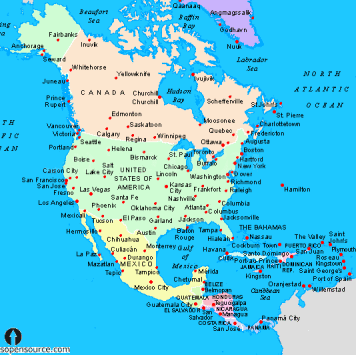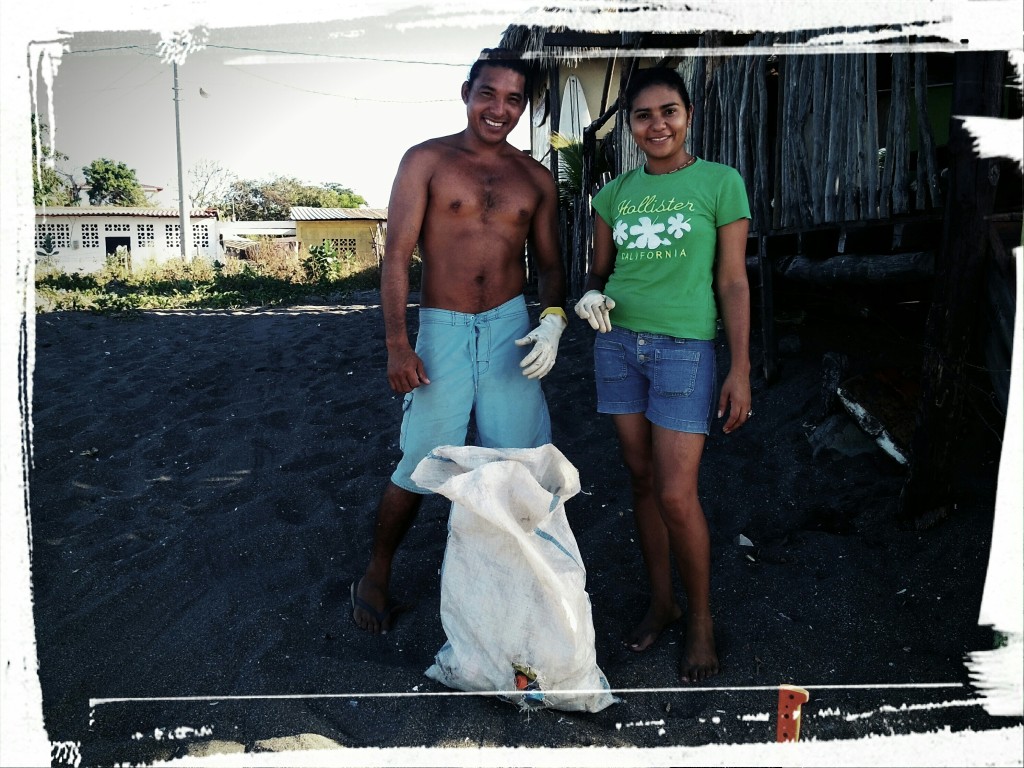FOR THE SOLUTION VIDEO TO THE FOURTH CHALLENGE, PLEASE SCROLL TO THE BOTTOM OF THIS PAGE!
 Title of the fourth challenge
Title of the fourth challenge
Valentina and Matt in Mountains of Trash
Related topic(s)
Resources, Governance, Education
We have now been in Nicaragua for exactly one month! Can you find us more or less on the map (we’re at Ometepe right now)?
We had the chance to celebrate New Year’s here and – curious to see more of the country – we escaped the heat in the city of Leon to spend the 1st of January on the beach. Because this is also how the locals traditionally start the New Year, a few thousand other people had the same idea and headed to the nearest beach.
That was definitely an interesting experience: The beach looked like a market with tons of small stands built out of palm leaves and bamboo, where food, snacks and drinks were being sold. Every millimeter of the rest of the beach was full of groups of people eating, drinking, and laughing together. Except for the fact that only a few of them were in the water (few people learn to swim here), everything seemed like a normal beach party or festival. The next morning only the tourists remained, since the locals generally go back to their homes, cannot afford the hotel prices at the beach or have to work the next day. With the bus costing about 50 cents (USD), a day-trip is often their best option.
So as we took our first steps onto the sand the next day to enjoy the empty beach, we were shocked by what we saw:
 The beach was fuuuuullll of garbage! After only a couple steps an empty plastic bag containing the dregs of some milky liquid was stuck to Valentina’s foot. The bag was from a local, sweet milk drink with ice is poured into the plastic bags and served with a straw in it. While she worked to remove the sticky, wet thing from her foot, Matt was standing in the middle of a pile of half buried, half blowing-in-the-wind-like-confetti Styrofoam and plastic cups, bowls, plates, utensils, etc. Yesterday, people were celebrating the New Year at the beach, eating nacatamales (filled corn polenta) or quesillos (a cheese tortilla with cabbage salad). The next day the material used for packing and serving all that great food and drink ruined the beach experience for the beach goers and those living there.
The beach was fuuuuullll of garbage! After only a couple steps an empty plastic bag containing the dregs of some milky liquid was stuck to Valentina’s foot. The bag was from a local, sweet milk drink with ice is poured into the plastic bags and served with a straw in it. While she worked to remove the sticky, wet thing from her foot, Matt was standing in the middle of a pile of half buried, half blowing-in-the-wind-like-confetti Styrofoam and plastic cups, bowls, plates, utensils, etc. Yesterday, people were celebrating the New Year at the beach, eating nacatamales (filled corn polenta) or quesillos (a cheese tortilla with cabbage salad). The next day the material used for packing and serving all that great food and drink ruined the beach experience for the beach goers and those living there.
Valentina took a look around and saw how the tide was slowly coming in and was taking some of the trash with it back into the ocean. “How practical” many of the local hotel owners probably thought. “How terrible” we thought. We remembered what the marine biologist told us at the turtle center in Mazunte, Mexico: When plastic bags float around in the ocean they look very similar to jellyfish, which are a favorite snack of the sea turtles. But when the turtles accidentally eat a plastic bag, it blocks their stomach and digestive track and they are unable to eat anything until someone (for instance, a veterinarian from the turtle center) can remove the plastic bag with an operation. This means that they die of hunger if they’re not lucky and are found in time. And the Styrofoam? Not any better: We saw once in a documentary (“Midway” by Chris Jordan) how it just gets smaller and smaller in the ocean until it looks like plankton, or basically like one of the favorite snacks of many birds and fish. That means that they die even with full stomachs, because they are full but have no nutritional value and they run out of energy to swim or fly.
And what does all of the garbage mean for people? Before we could even start thinking about what happens with the garbage that doesn’t end up in the ocean, we were getting whiffs of burnt plastic. That can’t be healthy, right?
A ticking time bomb! So we woke up our friends, organized garbage bags from the hostel where we were staying, and headed out to pick up trash before the tide could pull it out to sea.
The bad news: A drop of water on a fire? After an hour of picking up garbage our part of the beach was indeed clean, but we were nevertheless frustrated and overwhelmed by all of the questions that kept nagging us: How much garbage do humans produce on a daily basis? What happens with the garbage in Nicaragua, if it doesn’t get taken care of by either the sea or by fire (apparently)? Why does everyone just leave their garbage on the beach? And what is the garbage situation at other Nicaraguan beaches and cities/towns like?
The good news: Wherever there is a problem there is often already a solution in Latin America. Or at least efforts to solve the problem. We literally ran into one of these efforts after about fifteen minutes of picking up garbage: Lenni! Who or what is Lenni? Lenni is a local surfer who has started an environmental organization with hotel owners, citizens and other groups in the area, which is called PUMA, or Protección Urgente del Medio Ambiente (Urgent Protection of the Environment). Together they want to put so many drops of water on the fire that it goes out or doesn’t even start burning anymore. How? In order to avoid having such an acute garbage problem in the first place, they work to raise awareness (to reduce the amount of garbage and to deal with it better), organize garbage collection events similar to what we did, and collaborate with the local government in order to create a real, long-term waste management system (collection, removal, and processing/recycling). That is some good news for the beginning of 2014!
But all of our questions about garbage are still burning hot…Can you help us again and Lenni and his team from PUMA with your great research and find out a couple things for us?
For the solution video we need your help!
- What happens to plastic and Styrofoam when it’s not dealt with on land, but rather in the ocean?
- How long does plastic take to break down into its basic parts?
- What is plastic even made of?
- And what happens when it’s burned (healthy?)?
- How long does a banana peel take to decompose?
- What is a banana peel made of?
- Can plastic and Styrofoam be recycled?
We’d also really be interested in:
- How much garbage is produced at your school daily?
- How much garbage is thrown away on a weekly basis in Retz/Vienna/Lakewood?
- In the meantime we’ll try to find out some numbers for schools and cities/towns in Nicaragua!
While you work on finding the answers to these questions, you can again influence how our trip continues. We also would like to take a longer look at the topic of waste and check out the situation here in Nicaragua in more detail, while at the same time making a small contribution to reducing waste.
YOU DECIDE:
- Should we try to find people who know a lot about the waste issue(s) in Nicaragua and interview them (e.g. at the city or regional government levels)?
- Should we try to go a week without using/consuming plastic or synthetic materials (beyond what we already have with us in our packs)?
- Should we pick up garbage for half a day and then follow the garbage to its final destination in Managua?
Take a vote and tell us how many in your respective classes voted for each option. The votes for each option will be added to those from the other two classes. The majority wins this time. Regardless of how the vote goes, we’ll of course document the results for you and send you the solution via a video message in February!
HERE IS THE SOLUTION VIDEO:

